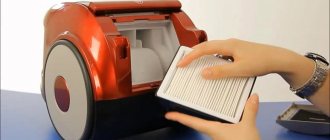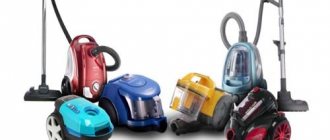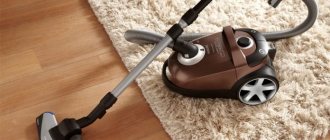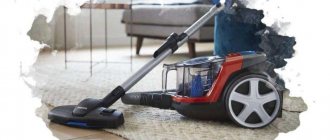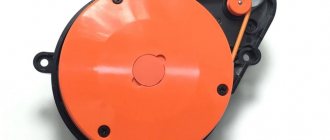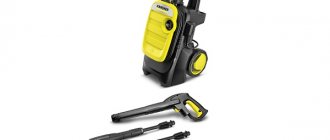Many people faced with renovation work realize how much garbage is left behind. To clean it, special construction vacuum cleaners are required. They are quite powerful devices that have a very wide range of applications.
They can be used both at large industrial facilities and at home. Currently, there are a large number of different models of such devices, differing from each other in technical characteristics, operational capabilities and functionality.
Do you really need an industrial vacuum cleaner? Is it worth the money?
Many people do not understand the difference between industrial and home vacuum cleaners, especially since they are very similar in appearance. The development of modern technologies has led to the fact that the design of traditional dust collection devices has become closer to more professional models. However, this is perhaps the only similarity between these types of vacuum cleaners. The “stuffing” of industrial devices is completely different.
We’ll talk about the technical stuff later, but now we’ll look at the advantages of industrial vacuum cleaners. Why is buying or renting such a device more profitable than a regular home one?
Firstly, industrial vacuum cleaners are named so for a reason. These are professional tools for removing dust and dirt from any surface, even if these very surfaces are nothing but “bare” concrete. Such equipment allows you to effectively get rid of not only dust, but also metal and wood shavings, loose paint, varnish, to remove fungi, mold and other substances and impurities that arise in homes, warehouses, production shops, workshops, factories and during various types of construction and repair work. With such vacuum cleaners, unlike ordinary household ones, you can even clean paths around the house!
Secondly, industrial vacuum cleaners are much more powerful than conventional devices. This is necessary in order to get rid of, among other things, larger and heavier elements than a piece of paint and plaster (for example, pieces of concrete and stones). Moreover, they have more durable bags (and there are models without bags), so you don’t have to worry about the operation of the device if you accidentally vacuum up, for example, several screws or nails.
Today, the range of manufacturers and models of such vacuum cleaning equipment is quite large. They all differ from each other in various parameters (power, class, container capacity, etc.), as well as in the nature of the application. Some models of professional vacuum cleaners are equipped with special attachments and accessories for removing dirt and dust in particularly difficult cases and hard-to-reach places.
Therefore, the choice of a suitable industrial vacuum cleaner depends mainly on the nature of current and future work, additional options, as well as the individual preferences of the user. But still, the main division of these devices is into 2 types: vacuum cleaners with bags and without bags. Let's look at their differences in more detail.
DeWalt DWV900L
This is another representative of German engineering that offers reliable technology. The company provides long-term and stable operation, and in case of risk of overheating, the device turns off itself. Unlike the above vacuum cleaner models, this one is more aimed at eliminating construction dust, which employees of cleaning companies often encounter.
The advantages include the following:
- Good collection of liquids.
- The suction power does not decrease over time.
- An outlet is provided for other equipment.
- Shockproof housing.
- The motor and switches are protected from dust and moisture.
- Blow function.
- There is an indicator that the waste container is full.
- High levels of maneuverability.
- Reasonable price - about 20,000 rubles.
Users note one of the disadvantages is the fact that the cable does not rewind automatically. There are also no additional attachments included. They will have to be purchased separately. You can use brushes from the manufacturer Karcher.
Which industrial vacuum cleaner to choose: bagless or bagless?
In professional vacuum cleaners without a bag (the so-called “cyclones”), all dust and dirt, instead of a bag, goes into a special built-in container. These devices operate on the principle of centrifugal force and a specially designed cyclone system, which removes harmful dust from the air using a centrifuge method.
Bagless vacuum cleaners are considered more durable and stable. Devices of this type are characterized by constant and high suction power throughout the entire service life of the device. The same cannot be said about vacuum cleaners with a bag - in them this parameter quickly decreases as the bag fills with dirt, which makes the device less effective or even ineffective after several hours of operation. In practice, this means that each time you have to change the bag more and more often, even before it is completely filled, and so on several times during the cleaning process.
However, buying an industrial vacuum cleaner with a cyclone system just to save money on cleaning bags is a serious mistake. Bagless cyclonic vacuum cleaners have their own “weakness” - dust filters, which break down faster and are more expensive than those installed in conventional vacuum cleaners with a bag. And cyclone vacuum cleaners themselves are much more expensive.
Another factor to consider when choosing a bagless industrial vacuum cleaner is the price and manufacturer. Devices that are too cheap and untested often turn out to be of poor quality. The efficiency of cheap vacuum cleaner models leaves much to be desired, to the point that some types of dirt and dust can be returned back into the room, and filters become clogged faster. Among the disadvantages of this model of industrial vacuum cleaners, the need to regularly clean the chamber should also be mentioned.
Is it worth paying extra for bagless cyclone devices? To be fair, we note that simple operation of industrial vacuum cleaners with a cyclone system is an order of magnitude cheaper than industrial vacuum cleaners with bags. Another undoubted advantage of these models is their greater efficiency and durability.
Built-in professional vacuum cleaners
Construction vacuum cleaner, BISON PU-60-1400 M4
A centralized dust removal system is another name for built-in professional vacuum cleaners. An air duct system connects the working hose with nozzles and the power unit with a storage container (which is located in an auxiliary room).
Manipulations during cleaning are carried out only with a light, long (from 4.6 to 10.7 meters) hose with functional attachments.
The undoubted advantages of a built-in professional vacuum cleaner are:
- all collected dust is completely removed from the room, rather than being driven through a vacuum cleaner
- the process is almost silent
- no replaceable consumables are used, and the combination of a cyclone and a self-cleaning fabric filter keeps the output air flow as dust-free as possible
- A large-capacity plastic dust collector can be serviced no more than 4 times a year.
- long, lightweight portable hose is easy to use
- Some models are designed for wet cleaning
The main disadvantage of built-in vacuum cleaners is the high cost and complexity of installation.
How to choose a suitable industrial vacuum cleaner?
When looking for a suitable bagless vacuum cleaner, pay attention to its parameters. If the equipment packaging does not contain information about the effectiveness of the device, it is better to refuse such a purchase.
What parameters are we talking about? For example, suction power. The higher this parameter, the better the air circulation in the chamber of the device, which is necessary for accurate absorption and accurate filtration of impurities. The suction power directly depends on the motor power, which should be at least 1200 W, and even better, 1600-1800 W. Everything is simple here: the greater the power of the vacuum cleaner, the higher its performance and efficiency.
Let's take, for example, a bagless industrial vacuum cleaner from the Karcher brand, which is very popular among builders. It has high suction power and is equipped with a multi-stage filter system, making it suitable for use in the most difficult conditions. With such a vacuum cleaner, you can effectively remove dry impurities, pieces of varnish and paint, and even spilled liquids from the floor.
In addition, these devices are made of highly durable and shock-resistant housing. Some models are also equipped with automatic filter cleaning systems and the ability to remove not only dirt, but also harmful dust. Thanks to these indicators, Karcher vacuum cleaners are truly universal devices.
Among other popular devices among developers, we note the industrial vacuum cleaner from Bosch. The products of this German brand have a long service life, and the vacuum cleaners themselves can handle both “dry” and “wet” work. In addition, Bosch vacuum cleaners are very powerful. High suction power means that with such a device you can cleanly remove dust and dirt not only from the floor of the house, but also from any other surfaces. An additional advantage of the product is its durable wheels, thanks to which you can quickly and easily move the equipment to the desired place and room, and even roll it around the site.
One of the most practical devices of this type is the bagless industrial vacuum cleaner with socket 1420. It is equipped with a special socket to which we can connect any electrical tool, such as a sander. The special mode allows you to control the vacuum cleaner using a power tool and the two devices work together, so you don't have to constantly be near the vacuum cleaner to turn it on and off.
Electricity consumption power
The motor is the heart of any equipment . It determines its performance.
Professional units have a power exceeding 1.5 kilowatts. Thanks to this, better suction of dust and construction debris is achieved for a long time. For comparison, household samples operate at a power of 300 W.
There are models equipped with soft start, which prevents overheating of the equipment.
A company like Makita has released a unit that fights various types of debris and is very productive. It has two excellent 1200 Watt motors. In these vacuum cleaners, communication between equipment is carried out in automatic mode. When you turn on, for example, the grinder, the vacuum cleaner is also activated. When it stops its operation, the device still continues to remove dusty debris for some time.
Industrial vacuum cleaners for production are equipped with a power unit that protects against overload. In cases where the tanks overflow when collecting liquid, they also turn off automatically.
Manufacturers indicate the power consumption of electricity in the attached specifications, as well as on the equipment housing.
The efficiency of the vacuum cleaner is ensured by the rotation speed of the turbines, which can reach 30 thousand revolutions per minute.
In the manufacture of equipment designed to remove contaminated liquids, motors with good insulation and air jet cooling are used, which protects against moisture from entering live elements.
To prevent short-circuiting of the windings, graphite brushes are replaced in a timely manner.
Industrial vacuum cleaners of cyclone type. Prices
The cost of bagless vacuum cleaners varies widely. Cheap Chinese models can be bought for only 4000-5000 rubles, while professional vacuum cleaners made in Germany will cost no less than 18-20 thousand rubles. The price of an industrial vacuum cleaner also depends on the type of filter, engine power and additional equipment. So, for example, professional vacuum cleaners with a power of 1800 W from Karcher or Bosch will cost at least 25 thousand rubles.
As we noted above, in this class of devices, a lower price almost always means less engine power and a lower class. This means that such equipment, despite the fact that it suctions dust well, cannot always cope with removing larger and heavier dirt and debris from the floor.
Voting by our readers:
Which vacuum cleaner model would you choose or recommend?
KARCHER WD 3 P Premium
0.00 % ( 0 )
AEG AP 300 ELCP
0.00 % ( 0 )
CALIBER SPP-1500/30
0.00 % ( 0 )
Bosch GAS 12-25 PL
0.00 % ( 0 )
Hitachi RP250YE
0.00 % ( 0 )
DeWalt DWV902L-QS
0.00 % ( 0 )
Nilfisk Buddy II 18L T
0.00 % ( 0 )
Meran VC-3/80TR
0.00 % ( 0 )
Metabo ASA 25 L PC
0.00 % ( 0 )
Fubag WD 4SP
0.00 % ( 0 )
KARCHER Puzzi 10/1
100.00 % ( 1 )
Windy Lavor Pro IE FORM Compressor
0.00 % ( 0 )
Krausen Eco Wash 20
0.00 % ( 0 )
Chibli Power Steam 5.3 MI
0.00 % ( 0 )
Is an industrial vacuum cleaner suitable for home use?
Professional construction vacuum cleaners are useful not only at construction sites, but also for traditional house cleaning. However, unlike conventional vacuum cleaners, in this case, high power is more of a minus than a plus.
Experts do not recommend using such equipment to clean the house after repairs or finishing have been completed. The fact is that industrial vacuum cleaners are designed mainly for rough cleaning of dust and dirt, and their equipment, attachments, brushes and accessories can inadvertently damage parquet or scratch tiles. Such equipment is ideal for use in the following stages:
- construction sites;
- repair;
- rough finishing;
- pre-finishing and final finishing;
- at stages when the floor in the house has not yet been laid (not installed).
However, this does not mean that an industrial vacuum cleaner will not be useful in your home after the renovation is completed. It can be useful when doing some housework. Eg:
- remove shavings from the workshop floor;
- remove from the floor pebbles and pieces of crushed stone that have fallen from the wheels in the garage;
- remove ashes from the fireplace and much more...
Then the question arises: which industrial vacuum cleaner would be the best solution for the home? And here we come back to power again. If you need a professional vacuum cleaner for regular home use, it is better to choose low-power models: 1000-1200 W is enough. With such motor power, the equipment can effectively cope with almost any type of contaminant.
Which model will be better for home: with a bag or without a bag?
If you have small children and allergy sufferers in your home, choose cyclone devices without a dust bag. In other respects, both types of vacuum cleaners are equally effective.
When purchasing a professional vacuum cleaner for your home, be sure to pay special attention to the accessories and attachments that the model you are interested in is equipped with. Ideally, they should be as close as possible in form and functionality to those found in traditional vacuum cleaners. The right brushes and attachments will allow us not to worry about the device scratching parquet, tiles and other finishing elements in our home.
For home use, an L class industrial vacuum cleaner is sufficient.
Features of the technology
A large amount of dust is inevitable during repair or construction work and must be removed immediately. It clogs the motors of power tools, thereby accelerating their wear, interferes with finishing work, and is simply harmful to the health of workers. The best solution would be to use a vacuum cleaner designed for construction waste. There are two types of this technology available.
Types of harvesting equipment
- Industrial models. Designed for production, have maximum power, and can withstand long-term heavy loads. Can work with hazardous and explosive substances.
- Construction units. Used for cleaning during renovation or construction, and for removing dust in home workshops. More powerful than household models.
For any household work, a construction vacuum cleaner is sufficient. There are two types of such devices.
Types of construction vacuum cleaners
- For dry waste. Collects only dry particles of dirt. Not designed to allow liquids to enter the dust container.
- For dry and wet waste. Designed for collecting dry dirt and liquids. With some models, wet cleaning is also possible.
Instagram electromontag.msk
Instagram leroymerlin_rnd
Another classification divides equipment into professional and semi-professional.
Semi-professional devices
Slightly different from household analogues. They are better suited for cleaning construction waste and are equipped with a more powerful engine. However, their capabilities are limited. The motor is cooled by the air leaving the filter; there is no bypass. The bags are often fragile and break when exposed to concrete fragments or metal shavings. There is no wet cleaning option. But the price is not much higher than that of household models.
Professional equipment
High-power units adapted for collecting contaminated liquids and dry contaminants. Particularly strong bags do not break; there are varieties that work without them at all. Some models can collect aggressive liquids and hot chips. A bypass is required to separate the air flows. The motor is cooled by a separate flow, and this extends its service life. The price of professional devices is much higher.
Any semi-professional model is suitable for cleaning during repairs or in the garage. But it is not suitable as a chip extractor for a home workshop. Here you need a professional unit or a special vacuum cleaner-chip extractor.
Instagram prokatcentr
Instagram tool77.ru
- Technique
How to choose the right snow blower: 9 important parameters and useful tips
Which industrial vacuum cleaner to choose for the garage?
Buying an industrial vacuum cleaner for the garage is the best solution, since such devices can remove almost all types of dirt and dust that accumulate in the garage, even in hard-to-reach places.
If your garage is clean and heated, a “home” model of a professional vacuum cleaner will be enough; if the garage is unheated and built separately from the house, it is recommended to choose more powerful models with which you can effectively remove pieces of snow, ice, dirt and pebbles from the garage floor . We are talking about devices with motor power in the range from 1200 W to 1400 W and class L or M.
Another important parameter is wet cleaning. When choosing an industrial vacuum cleaner for the garage, it is recommended to pay attention to models for both dry and wet cleaning. Thanks to this equipment, in most cases, you don’t even have to wash the floor in the garage - the vacuum cleaner itself will clean the floor of both soot and various oil stains.
Price categories
Keep in mind! By cost, industrial vacuum cleaners can be divided into three segments:
- Budget - from 3 to 6 thousand rubles. Lightweight and compact devices suitable for home use. They will help you put your apartment or garage in order after renovation.
- Medium - from 6 to 15 thousand rubles. More powerful units capable of removing construction waste in production conditions. They have a set of basic functions that allow you to efficiently clean your workspace.
- Expensive - from 15 to 130 thousand rubles. Modern models with automatic filter cleaning, power socket and other useful features.
Which industrial vacuum cleaner to choose for cleaning plaster?
Plaster is one of the most difficult finishing materials to clean. To get rid of traces of it, it is better to choose an M-class industrial vacuum cleaner. Such equipment has proven itself to be effective in absorbing dust, carpentry waste, aggregates, and paint residues.
The engine power can be any, in this case it is better to pay attention to the class of the vacuum cleaner. Of course, the H class model will also cope with cleaning plaster from floors and walls. Such devices allow you to clean your home from other types of construction waste: cement, plaster, asbestos, lead and even mold.
Purpose of construction vacuum cleaners
Keep in mind! Any construction work is accompanied by the formation of a large amount of waste.
Working in such conditions, you may encounter serious problems :
- dust is a strong allergen;
- visibility deteriorates and the quality of operations decreases;
- cutting tools wear out faster in dusty rooms;
- Many finishing works can only begin after all dust has been thoroughly removed.
Large construction debris is removed manually, but small particles are more difficult to deal with.
It is impossible to achieve a high-quality result with brooms and brushes; in the process of sweeping, a cloud of dust rises into the air.
A household vacuum cleaner will also not be a good helper - it does not have enough power to suck in heavy fragments and can throw particles harmful to health into the air.
In addition, abrasives will quickly render a device not designed for such an impact unusable.
Note! In such a situation, a construction vacuum cleaner comes to the rescue.
Its pipe can be fixed in the working area for timely removal of contaminants or connected to a power tool equipped with a special adapter.
The unit is also suitable for cleaning the room after completion of work.
Which industrial vacuum cleaner to choose for wall shredding?
Chipping concrete or brick walls always involves a lot of dust. Therefore, when choosing a vacuum cleaner for cleaning in such cases, it is recommended to pay attention to class L devices with special attachments for cable ducts and grooves. They make it much easier and easier to clean cavities in the walls.
There are also so-called special vacuum cleaners that work in synergy with hammer drills and grinders and automatically suck up dust. The rotating discs cause a lot of dust to be generated during its operation, so this tool is usually equipped with ends that allow it to be connected to an industrial vacuum cleaner.
In this case, you should choose an industrial vacuum cleaner equipped with an outlet for power tools. This solution ensures that both devices work synchronously, so you don't have to inhale a lot of dust, which is also harmful to our lungs.
Nuances of choice
The cost of the joint venture is quite high. And you shouldn’t rely only on its price and manufacturer’s brand. In order for your purchase to bring you effective results, vacuum cleaners must be equipped with:
- Conditions for future work. It’s worth deciding what model you need: professional, household or highly specialized. Which rooms will be cleaned? Will they be dry or with water? Will there be dust collecting or cleaning the floors? It is also important to look at the level of danger. It is usually indicated by manufacturers. L - low level, this is many construction pollution. A simple filter can also cope with them.
M – average level. These are: nickel, manganese, wood, copper and concrete dust. We need filters that capture 99.9% of such waste.H – high. These are various carcinogens (for example, asbestos), waste with a huge concentration of microorganisms, as well as chemical toxins. This requires powerful and sophisticated filtration technology for construction vacuum cleaners.
ATEX - special. This is the cleaning of easily flammable and explosive elements. Devices with a minimum electrical safety category of IP 54 are used.
- Vacuum level. The fan of the device creates a certain vacuum. It affects the suction power of the device. For SP, this parameter lies in the range of 17 – 250 mBar. The more developed the vacuum, the more massive elements the unit absorbs.
- Dust collector parameter. Typically its volume is: 20 - 50 liters. If you need to clean small spaces and volumes of garbage, it is illogical to buy a unit with a massive dust collector. Professional versions can have a dust container with a capacity of up to 100 liters.
- Frame. Typically, impact-resistant materials are used for its manufacture: aluminum, steel (stainless steel), brass or reinforced plastic. A bumper can also be mounted to the body. It prevents the body from accidentally hitting any obstacles.
Power and performance. The higher the first parameter, the higher the second. Usual SP power: 1.0-1.4 kW. Due to this, their air flow rate reaches 50 liters of air per second. The power of professional devices is up to 7 kW. Potential – 60 – 100 l/sec.
Add-ons
They are not mandatory, but make the device easier to operate. The more there are, the more expensive it is.
Typically can be equipped with the following extras:
- Special socket. Located on the body of the device. Its function is to directly connect electrical instruments. When purchasing a joint venture, it is important to consider the power of the tools that you will connect to it. It is better to give preference to a tool with more power.
- Suction power controller.
- Automatic filter cleaning. This mechanism is located above the filter and has a special valve, thanks to which the vector of the air stream changes and the filter is purged, thereby eliminating contaminants from it.
- Adapters. They allow you to connect: – an SP hose to the dust extraction mechanism in tools, – special splitters – useful when you need at least two dust-generating devices at once.
- Indicator light. It reflects the condition of the vacuum cleaner and reports a clogged compartment (hose, filter or dust collector).
- Engine protection from overloads. This is a very useful option for industrial models used in harsh conditions.
Industrial vacuum cleaners. Which power is better?
The motor power determines the suction efficiency of the device, and it should be in the range of 1200 W to 2000 W, depending on what kind of work the vacuum cleaner will be used for. If you plan to use it also while cleaning the house, it is better, on the contrary, to choose less powerful models.
You should also make sure that he has additional equipment. All suction nozzles and telescopic tubes make it easy to remove stains, dust and dirt, even from hard-to-reach places.
Kinds
Typically, joint ventures are divided into household and professional modifications. They differ in parameters, potential, suction power, and duration of operation without pauses.
If you need to clean a small space and the job takes a few hours a week, an inexpensive household modification is suitable.
When cleaning is needed in a huge production facility and it requires a huge amount of time, a professional device is required.
Differences between SPs by purpose
The purpose here is the type of pollution that the joint venture must eliminate.
Based on this principle, the following models are distinguished:
- To implement dry cleaning. This is the simplest task. All joint ventures cope with it.
- For combined cleaning: dry and wet. Such modifications cope with dry debris deposits and spilled liquids.
- For washing. The devices perform both dry cleaning and wash floors in rooms with high traffic.
- For cleaning waste that poses a risk of fire or explosion, for example, aluminum and zinc powders, coal dust, organic industrial waste. The motors in devices for such cleaning do not have graphite brushes. Also in these joint ventures there is an option to calculate the dynamics of air flow.
- For cleaning premises from hot industrial waste. These are heat-resistant devices. Scope of application: metal processing shops.
Principle of operation
When voltage is applied, the electric motor drives the fan, which creates a rarefied atmosphere in the device body. The result is a powerful air stream that sucks particulates through the hose and sends them into the dust bag.
To prevent the smallest particles of debris from entering the air, a special filter is installed at the outlet of the air flow, as a result of which only purified air enters the room.
Service principles
These principles boil down to regularly cleaning or replacing filters, as well as the dust container.
If the joint venture has a paper bag, then it is simply replaced. Other types of dust collectors need to be emptied of their “content” and thoroughly cleaned.
Filters
If you have a simple SP model, then you need to clean them yourself: the clogged filter is removed, cleaned, washed with running water and dried.
If you have a more powerful version, then the cleaning is automatic. You only need to press a button, and a powerful air flow, moving in a reverse vector, will quickly rid the filter of all dust.
If you are working with a high-end device, then you won’t even have to worry about dirt in the filters. In such models, self-cleaning of these components periodically occurs.


